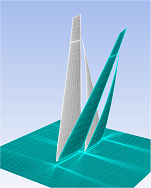
An article involving the use of RBF Morph having title “Sails trim optimisation using CFD and RBF mesh morphing” has been published on the journal “Computers and Fluids”.
Available online at:http://dx.doi.org/10.1016/j.compfluid.2014.01.007
DOI information: 10.1016/j.compfluid.2014.01.007.
Full bibliographic details: Computers and Fluids 93C (2014), pp. 46-60.
Abstract
The study is focused on the use of mesh morphing to explore different trims of yachts sails.
In particular, four trims of the fore and aft sail of a model-scale sailing yacht were modelled leading to 16 configurations in total.
Sail pressure distributions were validated with wind-tunnel measurements for all the 16 configurations, and full verification and validation was performed for one of these conditions.
The 16 configurations were modelled with two different approaches: generating a new mesh for each trim condition (standard method) and using a morphed version of the baseline condition.
This second novel method, based on the use of radial basis functions to morph the mesh, allows the computational time of exploring different geometries with computational fluid dynamics to be significantly decreased.
Good agreement is observed between the pressure distributions computed with new meshes and morphed meshes.
In order to show an example of trim optimisation, a metamodel approach is defined for the estimation of the response surface using radial basis function interpolation in the parameter space.
Thanks to the continuum nature of morphing approach, the optimal trim angles for the given flow condition could be verified using new full computational fluid dynamic simulations.
The original full factorial map of 16 points was replaced with a new map of 9 points with an optimal space filling approach to understand the faithfulness of a reduced metamodel. In both cases optimal point is evaluated using a fine design of experiment table built using the metamodel (41 levels for each parameter).
The maximum thrust is achieved at the same trim for both metamodels.
Proposed method can be easily extended to a wide number of parameters.
Such flexibility is demonstrated in the present paper showing the sensitivity of results with respect to apparent wind angle and heeling angle.



